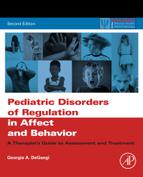Table of Contents
Chapter 1: Problems of Self-Regulation in Children and Adolescents
1. The concept of self-regulation and its development
What is a regulatory disorder?
3. Clinical significance of regulatory problems in children
4. Outcomes of regulatory disordered infants
5. Early symptoms and their relationship to later diagnostic outcomes
6. Impact of early symptoms on later developmental outcome
7. Types of regulatory problems
8. Case illustrations of the different subtypes of regulatory disorders
9. Identifying problems of self-regulation in infants and children
Chapter 2: Treatment of Irritability and Other Mood Regulation Problems
3. Physiological aspects of emotion
5. The socialization of emotions
6. Modulation of emotion and mood states
7. A developmental–structuralist approach to organizing sensory and affective experiences
8. Application of developmental–structuralist model
9. of a child with difficulties in various emotional stages
10. Identifying causes of mood dysregulation
Chapter 3: Anxiety Disorders: How to Calm the Anxiety Cycle and Build Self-Confidence
2. Neurobiological mechanisms underlying anxiety
3. Types of anxiety disorders in children
4. Posttraumatic stress disorder
5. Strategies to alleviate anxiety
Chapter 4: Dealing with Depression
3. Neurobiological bases for depression
4. Four portraits of depression
5. Effective treatments for children suffering from depression
3. The developmental stages of eating
6. Case example 1: it’s a family affair
7. Case example 2: the impact of early deprivation and an attachment disorder on feeding
8. Case example 3: food aversions and behavioral resistance at mealtime
2. Impact of sleep problems on development
3. Development of sleep–wake cycles
5. Self-soothing and the process of sleep
6. The sleep environment, cultural beliefs about sleep, and family sleep patterns
7. Sleep problems in children with dysregulation
8. Evaluating sleep problems in the child
9. Management of sleep problems
Chapter 7: Obsessive–Compulsive Disorder: How to Build Flexibility and Budge Compulsive Thinking
1. What is obsessive–compulsive disorder?
2. Is there a difference between healthy rituals and obsessive–compulsive behavior?
3. What causes obsessive–compulsive spectrum disorders?
4. How can this disorder be treated?
5. Steps to overcome obsessive–compulsive disorder
6. Common pitfalls: things to avoid
7. Case example 1: facing a germy world
8. Case example 2: stuck in endless repetitions
9. Case example 3: compulsive checking
Chapter 8: Treatment of Attentional Problems
1. Types of attentional problems
2. The processes that underlie attention
3. What is attention? Some historical perspectives
4. Arousal, alerting, and sensory registration
5. Sustained attention: attention getting and attention holding
6. The role of effort in attentional tasks
7. Selective attention: screening and selection
8. Motivation, persistence, and self-control
10. Case example of child with attentional problems
12. Case example: the plight of the procrastinator
13. Case example: when a whole family struggles with ADHD
1. What is sensory integration?
2. Sensory integrative dysfunction
3. The concepts of sensory defensiveness and sensory dormancy
4. Clinical assessment of sensory integrative dysfunction
6. The vestibular and proprioceptive systems
9. Case description: the gravitationally insecure child with developmental dyspraxia
10. Case example of treatment approach with child with pervasive developmental disorder
1. Overall philosophy of treatment
2. Attachment patterns of children with dysregulation
5. Case example of CCA with a dyad with a disorganized attachment disorder
6. Reparenting the client to provide nurturing and safety in the therapeutic relationship
2 Activities for Problems of Touch
3 Moving for Mood Regulation and Sleep
5 Distractions for Emotional Regulation
7 Mindfulness: Stilling the Mind
8 Systematic Relaxation: Stilling the Body
10 Finding Pleasure and Making Connections
11 Creating Positive Life Experiences
13 Increasing Personal Effectiveness
16 Keeping Track of Positive Behaviors
17 Eating Habits and Nutrition
18 Strategies for Improving Sleep
